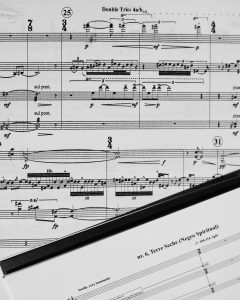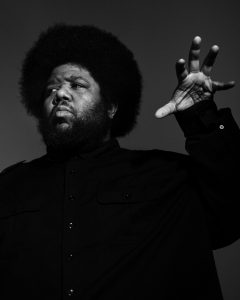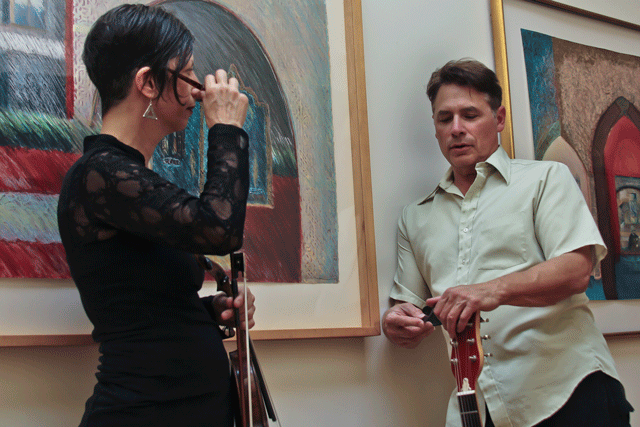The Composer Tyshawn Sorey Enters a New Phase
The Newark native has long been lauded for his brilliant abstractions. Lately he’s writing about something more concrete — and producing his most powerful music yet.
Jan. 7, 2021
On March 6, hardly a week before the pandemic lockdown began, close to a hundred people packed into the Jazz Gallery in New York City to hear a new sextet led by the drummer Tyshawn Sorey. When seats ran out — maximum occupancy is 75 — people stood against the wall or huddled together on the floor by the stage. Rio Sakairi, the club’s artistic director, worried that the city would shut down the concert as she passed around hand sanitizer. The anticipation in the room was tinged with dread. The death of the great jazz pianist McCoy Tyner was announced that day, and as we waited for the band to go on, his 1967 album, “The Real McCoy,” played on the loudspeaker. The two musicians had never met, but Sorey was so devastated by Tyner’s death that he nearly canceled the concert.
By Sorey’s standards, the set was a short one: only two and a half hours. Sorey specializes in slow-moving “durational” music — on his first album with this sextet, “Unfiltered,” songs run as long as 55 minutes — and the music that evening flowed in a contemplative, somber vein, now and then building to moments of ferocious intensity. You could hear faint, beautifully modulated echoes of 1960s jazz: the dark modernism of Andrew Hill, the gnomic lyricism of Wayne Shorter, the gnarled intensity of John Coltrane, the raucous counterpoint of Charles Mingus. But what impressed me most was the confidence and authority of the orchestration. There were no breaks between songs, just an uninterrupted, seamless odyssey of music-making, anchored and steered by Sorey, in his signature Afro, sunglasses and a loose black button-down. Sorey is a big man, but he moved around his drum set with almost balletic grace, poise and concentration. As a coda, he led the band in a stirring rendition of Tyner’s ballad “Search for Peace.”
When the set was over, Sorey said, he could hardly speak; he wanted to “live in that experience longer,” not hang out. So he slipped out of the club, only to be accosted by a group of older white admirers in the elevator. He smiled politely at their praise, but it was clear he preferred to be left alone. “I’m sorry,” he explained, “but I’m just feeling emotional about McCoy.” After we said goodbye on the street, he drove through the Lincoln Tunnel to his hotel in New Jersey and, still thinking of Tyner, “cried for hours.”
Sorey who turned 40 over the summer, would be worth writing about for his drumming alone. The power, precision and inventiveness of his playing often draw comparisons with masters like Max Roach, Elvin Jones and Tony Williams. But Sorey refuses to play conventionally virtuosic drum solos — he prefers to play delicately and sparely, if at all — and he avoids being photographed with his sticks in the athletic poses that have defined the image of most jazz drummers. He is also a brilliant trombonist and pianist, and in the last few years he has become as arresting a figure in contemporary classical and experimental new music as he is in jazz: a favorite of The New Yorker’s classical-music critic Alex Ross; one of few Black composers ever to be invited to the new-music festival in Darmstadt, Germany; and a recipient of a 2017 MacArthur “genius” award.
Sorey is one reason the worlds of jazz and classical music — of music that’s improvised and music that’s notated — seem less and less separate today. He’s far from the first jazz musician to compose for the classical concert hall: In the 1950s, there were “Third Stream” composers (Gunther Schuller, Jimmy Giuffre, John Lewis) who wrote for ensembles of classically trained musicians and jazz improvisers. But Sorey is neither “combining” genres nor “crossing over” from one into another. He does not so much bridge genre divides as cast them aside, as if they were a vestige of a prehistoric era, before artists as versatile as himself walked the earth. He can memorize and perform a complex score after glancing at it for 30 seconds, but he has no interest in reproducing sheet music note for note — including his own compositions, on which he expects musicians to improvise. “Playing with Tyshawn is like being onstage with the ocean,” the flutist Claire Chase told me. “You’re there with the ocean, and it’s serene and also dangerous and terrifying.”
I remember feeling somewhat at sea myself the first time I heard him perform, in 2014 in a trio with the pianist Cory Smythe and the bassist Chris Tordini. The stage was so dark that I felt as if I’d wandered into a séance. For the next two hours, they performed a hauntingly ruminative suite of semi-improvised chamber music, upending the conventions of the “jazz piano trio,” in which a pianist leads a rhythm section. At times Sorey seemed to do little more than brush his cymbals, creating whispering sounds. At others he sat still while Smythe and Tordini interpreted his score, letting the music drift in near silence until it was shattered by the crash of his drums, so clear and so bright that the room itself seemed to light up. The music’s beauty lay in the fragile truce it achieved between calm and turbulence, between creating a mood of contemplative stillness and channeling all the forces that menace it.
Sorey sometimes says his work is about “nothing” other than itself, but also describes it as “the means through which I ‘talk’ about social issues and other matters.” Both are true at once: His music is formally abstract but also permeated by his experience, especially his experience of Blackness. This does not always express itself in obvious or even audible ways; until recently, it has tended to emerge obliquely, down in what Ralph Ellison called the “lower frequencies.” Lately, however, Sorey has become more explicit about the moral and political passions beneath the rarefied surface of his aesthetics, writing vocal music set to poetry about Black lives. Silence and abstraction may remain his pillars, but he has given them a more explicit context and grounded them in more accessible forms. A result is some of the most expressive and powerful music he has written so far.
When I first suggested a profile to Sorey last January, he was preparing for the Paris premiere of his oratorio about Josephine Baker, “Perle Noire,” which was written for the soprano Julia Bullock and set to texts by the poet Claudia Rankine. By the time we began talking in late March, all such events had been canceled. And as the pandemic unfolded its strange monotony and appalling casualties, the mix of stasis and upheaval in Sorey’s music struck me as almost eerily prefigurative of this era in American history. Performing artists were facing the literal cancellation of their culture; Sorey told me in April that he was afraid that he “might be looking at the end of my career as a performer.” A number of prominent jazz musicians would die of Covid-19: Ellis Marsalis,Henry Grimes, Lee Konitz, Wallace Roney. As an overweight Black man with asthma, Sorey was acutely aware of being at risk himself. He and his wife would eventually decide to home-school their young daughter, Naima, to help protect him from the virus. He was lucky to have plenty of high-profile commissions, but there was no telling when or how this new work would reach the public. “I’m writing music for the desk drawer,” he told me.
We spoke on Zoom almost every week for the rest of the year. He was invariably in his office, dressed in black, with the lights off, boxes of CDs on the shelves behind him. Our conversations sometimes lasted for hours. Interviewing Sorey is a bit like listening to his music: a plunge into the longue durée, an introspective anatomy of what he has called the “cycles of my being.” The latest cycle, from the pandemic to this year’s killings of Black people by the police, has felt especially unsettling to him. At first he calmed his nerves by watching comedy (the absurdist “The Eric Andre Show” is a favorite) and posting about racism on social media, updating his thousands of followers on his state of mind. “I’m just doing what I need to do to survive,” he told me. But as the pandemic wore on, the convulsions of the late Trump era would propel him to embark on his most ambitious work yet: a vast book of songs about his own survival, and the survival of other Black Americans in the land they call, for better or worse, home.
Sorey was born in 1980 in Newark. His parents, who mostly did odd jobs, split up when he was 3, and he and his mother were evicted from their apartment soon after. They moved into a housing project, but as the crack epidemic spread, life at home grew increasingly precarious, and Sorey preferred to stay with his paternal grandmother, Evelyn Smith, a day-care teacher who died in 2014. At 12, he moved into her apartment in Clinton Hill, among Newark’s most violent neighborhoods. Both parents remained in his life, but it was a “dark time,” he says, and he prefers not to talk about it.
By 7, Sorey had been making sounds on radiators and pots and pans and playing hymns from memory on a beat-up piano in the basement of the Catholic church he attended with his grandmother. He wanted to play drums, but there were no drum sets at his elementary school, so he took trombone lessons instead. Later, his maternal grandfather, Herman Edward Sorey, gave him his first set. He also remembers his paternal uncle Kevin Smith, who looked out for him during his father’s frequent absences, taking him on jazz-buying expeditions at a record store in Elizabeth, the next town over.
Like many Black children, Sorey was consigned for much of his youth to special education, possibly because of the slight lisp he still has. He was also bullied by other children, ridiculed as the overweight kid who walked around with a boombox listening to “white folks’ music.” (“It didn’t matter that it was Miles Davis,” Sorey recalls. “They didn’t know I was also very into hip-hop.”) His other comfort zone, besides music, was “Columbo,” the detective show; in Peter Falk’s character, he found a fellow oddball who cunningly took advantage of being underestimated. “I loved the pacing of each investigation,” he says. “Two hours is a long time for a kid to watch something like that. But a ‘Columbo’ episode is akin to a strangely modified sonata form — kind of like Beethoven’s mastery of it.”
At Newark Arts High School, he studied trombone but also listened to all the great drummers — especially Max Roach, Elvin Jones and Tony Williams — and fell under the spell of Coltrane’s late expressionistic period. When he was 17, one of his teachers introduced him to someone who’d been among Coltrane’s fiercest champions: the Black Arts poet and critic Amiri Baraka, formerly known as LeRoi Jones. A native son of Newark, Baraka lived not far from Evelyn Smith’s house and ran a music-and-poetry salon called Kimako’s Blues People out of his basement. It was at Baraka’s salon that Sorey met generations of radical artists and visiting jazz ambassadors, including Max Roach himself, receiving an education in “the Black agenda” — lessons reinforced by his uncle Kevin, who taught him the history of Newark’s 1967 uprising and played him speeches by Malcolm X.
But Sorey’s strict adherence to this agenda was challenged when one of his teachers asked him if he’d ever listened to 20th-century music. Sorey assumed that meant R.&B. and hip-hop, but the teacher was actually referring to 20th-century modernist composers like Karlheinz Stockhausen and Pierre Boulez. Sorey listened and was riveted by what he heard. The dissonance of the European avant-garde spoke to him: “My very being is dissonance,” he told me. (He was delighted when I showed him Duke Ellington’s remark that, for Black people, “dissonance is our way of life in America. We are something apart, yet an integral part.”)
The sounds of the classical avant-garde also felt strangely familiar. They reminded him of the albums he was borrowing from the local library by experimental Black artists, like those in the Chicago-based Association for the Advancement of Creative Musicians (A.A.C.M.), especially the reed man Anthony Braxton. Braxton mentioned Stockhausen and John Cage alongside jazz players among his influences; he used numerical and visual symbols for titles; he appeared on album covers holding a pipe. Braxton shook up Sorey’s sense of what a Black musician could be, making him “more of a universalist,” he says, both in his person and in his sense of art.
In 1999, Sorey went to William Paterson University on a full scholarship, starting out as a trombone student before switching to drums. He majored in jazz, but he chafed at the traditionalist streak in the jazz department. He found a sanctuary in the new-music program, which introduced him to even more sounds he had not explored. In his first semester, he overheard one teacher, the pianist Anton Vishio, playing a brutally staccato piece by Bartok and rushed in breathlessly to ask what it was; the next time they met, Vishio remembers, “Tyshawn was playing the hell out of it on piano,” an instrument he’d never formally studied.
Vishio also introduced Sorey to the work of Morton Feldman, the son of Russian-Jewish immigrants in Queens, who wrote some of the quietest and most ravishing music of the second half of the 20th century. “Feldman’s work made me want to be myself and to pursue beauty in a similar way,” Sorey told me. “I loved the fact that it was quiet. I loved the chromaticism, and I loved the use of gesture.” The composer held another attraction too: A tall, bulky man who weighed roughly 300 pounds, Feldman was the only Jewish member of the New York School of composers led by Cage. He considered himself an outsider, even a misfit, in “Western-civilization music.” His ancestors, he said, were “with me” — “I have the feeling that I cannot betray this continuity, this thing I carry with me. The burden of history.” For Sorey, Feldman suggested a compelling way of reconciling abstraction and collective memory, formal beauty and ancestral trauma.
Sorey also investigated his Black musical ancestors. Some came from the jazz avant-garde, like Braxton and the saxophonist Roscoe Mitchell, another leader of the A.A.C.M. Others were modernist composers who wrote for classical ensembles, like Hale Smith, Olly Wilson and George Walker. The two groups sounded as different from each other as they did from the Euro-American avant-garde. But the more Sorey listened, the more he came to see each of these streams as a tributary of the same river of experimentation, artificially segregated by genre and race. While Euro-American composers experimented with chance and “aleatoric” writing, Black avant-gardists invented their own nonstandard methods, from the trumpeter Wadada Leo Smith’s painted “Ankhrasmation” scores to “conduction,” a system of hand signals for improvisers devised by the cornetist Butch Morris. There were many ways of arriving at the shore of new sounds. Sorey wanted to know them all.
While still at William Paterson, Sorey made a name for himself as a sideman on the New York jazz scene. He had a photographic memory for sheet music, perfect pitch and mathematical precision. His only liability was what Sorey himself calls his “very short fuse — there was a sort of arrogance mixed with a deep insecurity about what I was doing and who I wanted to be.” At one student recital, he stormed offstage, frustrated by his band’s performance. On his first European tour with the pianist Michele Rosewoman, he was at one point so insubordinate toward Rosewoman that after the tour, another sideman said, “If you were in my band, I’d have put you back on the plane.” “Tyshawn learned a lot of social skills later on,” says Rosewoman, who continues to have great affection for him. “He became someone who could work with other people.”

Rosewoman chose not to continue working with Sorey, who says, “I still recoil in absolute horror at my 21-year-old self.” But working with Rosewoman ended up connecting him with someone who gave him his next big break: the pianist and composer Vijay Iyer. When they met to explore playing together, Sorey stunned Iyer, who expected to hear him play only drums, by sitting at the piano and playing one of Iyer’s improvisations and a piece by Stockhausen, both from memory. Late in 2004, Sorey joined Fieldwork, a trio with Iyer and the saxophonist Steve Lehman, and before long he was writing half the group’s music.
Iyer sensed Sorey’s unease with the role of a drummer, “something that was both too much and not enough for him.” Sorey loved playing with Fieldwork, but it infuriated him that when they went on tour, people saw him as the large Black man pounding the drums — “someone who’s supposed to perform music designed to entertain,” he says, “because that’s one of the only two things we’re ‘really good at,’ other than sports.” (As much as he admires the rapper Kendrick Lamar, Sorey thinks awarding a 2018 Pulitzer Prize to a commercial hip-hop record was something of an insult to the many Black composers of concert music who have been overlooked for the prize.) He had similar misgivings during a 2009 European tour with Paradoxical Frog — a trio with two white women, the Canadian pianist Kris Davis and the German saxophonist Ingrid Laubrock — but he never shared them with his bandmates. Davis worried that Sorey was expressing discontent (or boredom) by playing loud or walking offstage, sabotaging the music, but Sorey felt he was simply “responding to the energy in the room,” reclaiming his power with wordless protests. “That question about sabotaging the music comes from a place of privilege,” he says. “They have the luxury of not being asked, ‘Did you write that?’ like it’s some kind of surprise.” After I told him about Davis’s remarks, he emailed her; they’ve since reconciled and made plans to play together again. But even today, Sorey confessed to me, “I sometimes think I’m being too careful or overly sensitive about how others might view me as a large Black man making music.”
By the end of the Paradoxical Frog tour, Sorey had grown tired of playing in other people’s groups. He had already released two albums of his own music, both quietly forceful declarations of artistic independence. The first, a two-disc set called “That/Not,” was full of long tones, with austere, almost ritualistic repetition and passages of silence; one piano piece had six notes sounded in an almost relentless variety of voicings and sequences for more than 40 minutes. The next, “Koan,” was even more abstract, a mesmerizingly atmospheric work for drums, bass and guitars.
Sorey’s career as a leader was beginning to take off, but he was still living from gig to gig. On his occasional visits to Newark, relatives would ask how he planned to make a living; his father thought he would be better off getting a job at the Essex County jail, where his uncle Kevin worked. Instead, he applied to the master’s program in composition at Wesleyan, where he studied under his hero Anthony Braxton and the experimental composer Alvin Lucier. He also met his wife, Amanda L. Scherbenske, a violinist from a German-Russian family in North Dakota who was writing her Ph.D. thesis in ethnomusicology and leading a klezmer group on the side. Sorey joined her band in part, he says, to win her over. They soon found themselves “exquisitely connected,” in her words, by their love of music and their experiences of family trauma. Scherbenske was dazzled, and a little intimidated, by Sorey’s musical facility, especially when he picked up an old violin and, within five minutes, taught himself to play a few things. But she also understood his insecurities in a way no one else had before, and she helped him wrestle with feelings of shame and lack of “self-love” that go back to his childhood in Newark. She was also instinctively pragmatic about his career. When Sorey considered doing his Ph.D. at SUNY-Buffalo, because Morton Feldman once taught there, she told him: “Buffalo is not going to do anything for you. Columbia is where you go.”
By way of introduction, first-year composition students at Columbia University are required to present some of their work. Sorey’s first presentation, in the fall of 2011, was such a flop that he nearly quit the program. The other students wrote in a more academic style; Sorey presented experimental jazz. At first no one said anything. Finally, someone asked about his approach to improvisation. “I made some kind of intellectualized comment, and then he said, ‘Can you say it in your own words?’ He might as well have said, ‘Speak Ebonics.’ So I spoke without intellectual poise, and he said, ‘That’s the answer I was looking for.’ I never presented a single other piece of music in that seminar.”
Still, he tried to fit in by writing his first piece of 12-tone serialism. At its premiere, he felt as if he’d betrayed himself. In 2012, at an artists’ residency in Northern California, he was explaining the formal devices he used to write the piece to a group of senior composers, when the ambient composer Harold Budd helpfully shouted, “I don’t give a damn how it’s made!” “Everyone laughed,” Sorey remembers. “I laughed, too.” Then he played a selection from “Koan.” “Now that sounds like you,” Budd declared. “Here I was trying to be this Princeton-Columbia type of intellectual composer,” Sorey says, “and everybody hated it. Even I hated it.”
Back on campus, he attended a performance at which Courtney Bryan, one of the few Black students in the composition program, played a piano solo inspired by an African-American spiritual. “It moved into a very dark area in terms of harmony, with a real acerbic sense. I heard the struggle that I was feeling at that time at Columbia in her left hand.” He started to work on a new piece for piano, vibraphone and alto flute, taking the opening chords of an obscure late composition by Coltrane, “Untitled 90320,” and radically slowing them down to distill their melodic essence. The language is classical, but the tone colors are steeped in the Eastern-tinged modal jazz Coltrane pioneered. Sorey called this beguiling piece “Trio for Harold Budd,” in homage to the composer who reminded him that the beauty of his music mattered more than the beauty of his ideas. Since that moment, he said, he lost interest in “being the most avant-garde person in the room.”
During his first year at Columbia, Sorey took classes with the composer, trombonist and musicologist George Lewis, a member of the A.A.C.M. But at Lewis’s urging, he worked most closely with the composer Fred Lerdahl, a specialist in tonal harmony, who advised his thesis. (“We’re going to work together beyond Columbia,” Lewis told him — and “you’re going to get so much from Fred that you’re not going to get from me.”) At their first class, Sorey listened to Lerdahl playing Brahms, and “a light bulb went off in my head — I felt at home there, with him playing this beautiful music.” He said he wanted to learn how to build larger forms with chromatic harmony; Lerdahl told him to return the next week having written something reflecting that. This was the beginning of Sorey’s “Slow Movement for Piano,” a work of wintry Romanticism later recorded by his trio. Lerdahl liked Sorey’s initial sketch but says he encouraged him to “make your compositions as coherent and logical as your improvisations. It almost sounds like you’re speaking two languages, and you need a unified language.” Sorey was so shaken by Lerdahl’s respect for him as a composer that “I literally broke down and told him some of my insecurities and issues. He said, ‘You really need to embrace everywhere you come from, and the difference between yourself and your colleagues.’”
He experienced a similar jolt when he read “In the Break,” an influential study of Black aesthetics by the cultural theorist Fred Moten. Sorey found an almost personal vindication in Moten’s argument that Black musical creativity isn’t an outgrowth of the blues or some other vernacular essence, but that it stems from a resistance to any kind of confining categorization. If Sorey wanted to write music influenced by Brahms or Feldman, that didn’t mean he was betraying his Black roots or his radical principles. On the contrary: He was expressing his freedom both as an artist and a Black man. All the music he’d studied, he realized, whatever its ethnic or racial identity, belonged to him. The way he interpreted it, and interwove it with his jazz background, ensured that his work would contain, like Ellington’s, “the sound of our experience, the sound of the Negro experience.”
This revelation led to new work of astonishing breadth and variety. There was “Alloy,” for his piano trio; “The Inner Spectrum of Variables,” a two-hour suite for the trio and three classically trained string players; “Perle Noire,” the evocation of Josephine Baker’s life as a Black artist in exile; and “Pillars,” a four-hour electroacoustic piece full of ominous drones and reverberations. These were followed by improvised duets of striking elegance and formal cohesion, plus “Unfiltered,” an immersive, richly melodic work of straight-ahead jazz.

Sorey was finally writing the kind of music he wanted to hear, and being rewarded for it: He graduated from Columbia in 2017 with an appointment from Wesleyan, followed by the MacArthur. But not everyone could play Sorey’s scores. While he generally uses traditional Western notation, Sorey expects musicians to be able to move off the page and improvise, and collaborators have grown accustomed to showing up for a concert only to be told that they will be playing parts of the score in a different order, or backward. For most classical musicians, this is asking a lot. During the recording of one piece, when the string players were having difficulty keeping up, Sorey made no secret of his frustration, stomping out of the room. “Take a breath,” Yulun Wang, one of his producers, told him. “These people are only human. Hold them to the highest standards you want, but remember they’re not you.”
When he first met with the International Contemporary Ensemble, a group of new-music players that has performed many of his scores, to discuss a possible collaboration, he told them: “I’m not interested in fusing or dissolving or creating a hybrid. I want to start from a place where the lines between notated and improvised music have disappeared completely.” There was a hush in the room. “The way Tyshawn made the invitation gave us a choice,” the flutist Claire Chase remembers. “Stay where you are, or come with me.”
In spring 2019, Sorey and Chase performed a duet for a group of Columbia donors in East Harlem, where one guest told Sorey he liked his Afro and suggested that he would look even better if he wore a dashiki or kente cloth and did the “Black thing” onstage. Days later, they performed the same piece at a retrospective of Sorey’s chamber works at Columbia’s Miller Theater. Some of New York’s best-known composers and musicians turned up. Still, Sorey felt disappointed when he learned Fred Lerdahl had been in the audience but left without saying hello. He later told Sorey that he felt the “pieces were too long and repetitious” and didn’t want to “cast a shadow” — though, he said, “my admiration for you and your talent is undiminished.” Sorey felt punched in the gut. One of his most enchanting recent compositions is a shadowy, nocturnal work titled “For Fred Lerdahl.” He was “thrilled” and, I sensed, relieved when I told him that Lerdahl considers it a “lovely piece.”
Many of Sorey’s titles, like Feldman’s, are dedications to mentors: homages to composers, often older men, whom he describes with gratitude, even reverence. Relations with his own family remain complicated and sometimes stressful. And when he returns to Newark, Sorey says, he still confronts a perception that “Blackness is one mold, one box, and that if you don’t operate in that box, you’re trying to be white, or you think you’re better.” His aim as a composer is to “move between different worlds,” but, he says, “I often have the feeling of disbelonging, of not belonging to any particular place — even if, lineage-wise, I’m a Black man.”
Last summer, Sorey had a real conversation with his father, Otha C. Smith III, for the first time in six years. Although he welcomed the thaw in their relations, he soon fell into a “big depression.” He declared that he no longer wanted to write long-form pieces and instead churned out spiky little bagatelles for solo instrumentalists, one as short as 30 seconds — works that, he confessed, sounded surprisingly like the academic style he tried to emulate and then abandoned at Columbia. He didn’t have the attention span for anything longer; the double menace of racism and Covid-19, and then his father’s reappearance, had left him feeling vulnerable and agitated.
In the fall, he bounced back. He and Amanda were expecting their second daughter in January and were living in a new home in a suburb of Philadelphia, where he has taken a tenure-track chair in composition at the University of Pennsylvania. Since the fall semester began, he has been back at his desk, early in the morning, writing at such an accelerated clip that the Times music critic Zachary Woolfe declared November “the month of Tyshawn Sorey.” One of the two just-completed commissions he premiered that month — “For Roscoe Mitchell,” a 20-minute composition for the cellist Seth Parker Woods and the Seattle Symphony — felt like a milestone. While it begins in a hushed style reminiscent of Feldman, it travels into far more dramatic terrain, with gorgeously baleful writing in the lower registers of the cello.
Sorey’s most important project, however, has been a series of art songs about Black lives in America, building on his 2018 work “Cycles of My Being.” A brooding, 40-minute setting of poems by Terrance Hayes, “Cycles” was one of Sorey’s most traditional “classical” works: It drew inspiration from the 19th-century German tradition of lieder, songs for solo voice with piano accompaniment. Its singer was a classical tenor, Lawrence Brownlee, and the instrumentation paid homage to Olivier Messiaen’s “Quartet for the End of Time.” With its nods to Brahms’s voluptuous writing for clarinet, Schoenbergian serialism and Steve Reich’s jagged strings, the music reveled in Sorey’s classical influences. Yet it was also Sorey’s most personal and most explicitly Black work — specifically, his most Ellingtonian work, insofar as it sought to create a musical parallel to the Black American experience.
Sorey says Ellington’s 1943 work “Black, Brown and Beige” weighed heavily on him as he wrote, especially its sorrowful “Come Sunday” section, which Mahalia Jackson sings with transcendent power on the 1958 recording. Like Ellington, Sorey wrote with his performers in mind, encouraging them to stylize his writing and “make that music yours.” He wanted to capture “the way we Black people like to do things, how our music depends on our feeling, our interpretation, at a given moment.” In an a cappella section toward the end, Brownlee embellishes the words “each day I rise,” while a male chorus solemnly exclaims “I know!” in a call-and-response; then comes an instrumental section in which the clarinet cries and screams over a piano tremolo. I wrote to Sorey that I felt as if he were saying: “This is where I come from. These are my people. This is who I am.” Indeed, he replied, “this is what I call the testifying section.”
Energized by the protests against racism and police brutality, Sorey initially set out to expand “Cycles” into a work of three or four hours. Instead, he has been writing new works for voice about race in America — works that he sees as an extension, rather than a part, of “Cycles.” Two of the compositions he wrote in the fall will premiere early this year: “Save the Boys,” for piano and countertenor, based on a poem by the Black abolitionist and suffragist Frances Ellen Watkins Harper; and a setting of Paul Laurence Dunbar’s poem “Death,” for piano and mezzo-soprano. “I’m talking,” Sorey says, “about the peril we continue to experience as Black men, and as Black women, too, as we saw with Breonna Taylor.”
Ever since the protests last summer, the classical-music world, like other spheres in American life, has been reckoning with its history of anti-Black racism, from orchestras’ exclusion of Black musicians to the neglect and erasure of Black composers. “I personally think it’s a day too late and a dollar too short,” Sorey says of classical music’s “awokening,” but it has sharpened his sense of urgency around the vocal music he has been writing. “As an artist and as a Black man,” he told me, “I have a responsibility to put this work out, and time is of the essence.” He now plans to dedicate himself to vocal writing, seeing it as the culmination of his work as a composer. But this work is also something of a departure: Unlike his more abstract writing, it is plainly “about something.”
The original musical spark for “Cycles of My Being” did not come from the blues or spirituals. It came from Schumann’s “Dichterliebe,” a sequence of 16 songs about love and betrayal composed in 1840. The romantic theme of Schumann’s cycle is personal, not political, but its ironic libretto is based on poems by Heinrich Heine, a German Jew who knew too well how it feels to love a country that doesn’t love you back. That bitter tale of unrequited love seems to be at the heart of Sorey’s new work; he listened to “Dichterliebe” obsessively while writing “Cycles,” drawn to the “simplicity of the writing and the clarity of the texts.” He realizes that there’s nothing simple about his love for them, at least not to others, but “why is it OK for white people to listen to Coltrane or Miles Davis but not OK for me to listen to Stockhausen or Feldman? It’s an age-old problem — and one that I continue to ignore.” When someone asks him, he told me, why a Black man like himself would write lieder, “my answer is: ‘Who owns music?’”
Adam Shatz is a contributing editor for The London Review of Books and a contributor for the magazine.
A version of this article appears in print on Jan. 10, 2021, Page 35 of the Sunday Magazine with the headline: Pieces of a Man.






